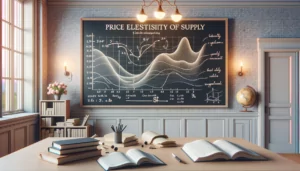In the dynamic world of economics, achieving equilibrium is a fundamental concept that plays a crucial role in shaping market-based economies. Equilibrium represents a state where opposing economic forces, such as supply and demand, find a delicate balance. This guide delves into the essence of economic equilibrium, its types, and its significance in understanding market behaviors.

✅ AI Essay Writer ✅ AI Detector ✅ Plagchecker ✅ Paraphraser
✅ Summarizer ✅ Citation Generator
Understanding Economic Equilibrium
Economic equilibrium is the cornerstone of a well-functioning market-based economy. It refers to the state where various economic variables gravitate towards their natural state, unaffected by external influences. In this state, market forces are in balance, leading to stable prices and optimal allocation of resources.
The Forces of Supply and Demand
At the heart of economic equilibrium lies the interplay of supply and demand. These two forces determine how resources, goods, and services are allocated within an economy. When the forces of supply and demand are in equilibrium, the market efficiently allocates resources to meet consumer needs and preferences.
The Role of Prices
Prices act as the guiding signals in an economy. They reflect the equilibrium state of supply and demand. If a product or service is in high demand, prices will increase, leading to an increase in supply as producers seek to capitalize on the opportunity. Conversely, if demand decreases, prices will lower, encouraging suppliers to reduce output.
Types of Economic Equilibrium
In economics, equilibrium can manifest in various forms depending on the context. Two common types of equilibrium are explored below:
1. Microeconomic Equilibrium
Microeconomic equilibrium focuses on the interactions between individual buyers and sellers in specific markets. The most prevalent form of microeconomic equilibrium occurs when the price at which goods or services are supplied matches the price at which they are demanded. This is visually represented by the intersection of the supply and demand curves on a price-quantity graph.
2. Macroeconomic Equilibrium
On a broader scale, macroeconomic equilibrium examines the overall balance of an entire economy. It encompasses various factors, such as aggregate demand and supply, interest rates, inflation rates, and production levels. Achieving macroeconomic equilibrium is a more complex task due to the multitude of interrelated variables.
Equilibrium vs. Disequilibrium
While economic equilibrium is a theoretical concept, real-world economies are seldom in a perfect state of balance. Disequilibrium refers to situations where the market is not balanced, and opposing forces are not in harmony. However, the economy is always striving to move towards equilibrium.
Causes of Disequilibrium
Several factors can disrupt equilibrium and lead to disequilibrium. For instance, protectionist laws implemented by a country, such as tariffs and quotas, can create imbalances in international markets by capping the demand for certain products.
Restoring Equilibrium
Economies tend to self-correct and move back towards equilibrium over time. When a market is in disequilibrium, it sets off forces that prompt adjustments. For example, if there is excess demand for a product, prices will rise, leading to a decrease in demand and an increase in supply, eventually restoring equilibrium.
Example: Efficiency of a Market-Based Economy
To better comprehend the efficiency of a market-based economy, let’s consider a small town scenario with one farm that produces all the food for its inhabitants.
In a centralized economy, a single entity would decide how the food is allocated among the townspeople. However, this method has its shortcomings as it may not consider individual preferences and allergies. On the contrary, a market-based economy allows people to trade items for food, leading to a more efficient distribution based on demand and preference.
Limitations of Economic Equilibrium
While the concept of economic equilibrium is a powerful tool in understanding market dynamics, it also has its limitations.
- Dynamic Nature of Markets: Markets are ever-evolving and subject to external shocks and changes. As a result, true equilibrium is rarely achieved in practice.
- Incomplete Information: Market participants may not always have access to complete information, leading to imperfect decision-making and potentially disrupting equilibrium.
- External Influences: Economic equilibrium assumes no impact from external factors, but in reality, events like natural disasters or policy changes can disrupt the balance.
Conclusion
In conclusion, economic equilibrium is the bedrock of market-based economies, representing the balance achieved when supply and demand forces harmonize. Whether at the microeconomic or macroeconomic level, equilibrium helps optimize resource allocation and price stability. While perfect equilibrium may be an elusive ideal, understanding its dynamics is crucial for economists, policymakers, and business leaders to navigate the complexities of the ever-changing economic landscape.
FAQ
How does the market-based economy influence economic equilibrium?
In a market-based economy, economic equilibrium is heavily influenced by the forces of supply and demand. The market mechanism allows prices to adjust based on the interaction between buyers and sellers. When demand for a product or service increases, prices rise, prompting suppliers to produce more and restore equilibrium. Similarly, when demand decreases, prices fall, reducing supply until a new equilibrium is reached.
Can economic equilibrium be disrupted?
Yes, economic equilibrium can be disrupted by various factors. Events such as natural disasters, policy changes, shifts in consumer preferences, or technological advancements can disturb the balance between supply and demand. Additionally, government interventions, such as price controls or trade restrictions, can also cause disequilibrium in the market.
What are the different types of economic equilibrium?
There are primarily two types of economic equilibrium. Microeconomic equilibrium, which focuses on individual markets and the balance between supply and demand for specific goods or services. Macroeconomic equilibrium, on the other hand, looks at the overall balance of an entire economy, considering factors like aggregate demand, inflation rates, and interest rates.
How is economic equilibrium different in microeconomics and macroeconomics?
In microeconomics, economic equilibrium is concerned with the balance of supply and demand for individual products or services in specific markets. It is depicted through the intersection of supply and demand curves on a price-quantity graph. In macroeconomics, economic equilibrium considers the overall state of the entire economy, involving various factors like aggregate demand, money supply, and production levels.
Does economic equilibrium always exist in real-world markets?
While economic equilibrium is a theoretical concept, it is rarely fully realized in real-world markets. The dynamic nature of markets, along with the constant influence of external factors, means that markets are always in a state of flux. However, the concept of equilibrium serves as a useful reference point to understand market behaviors and trends.
How do supply and demand play a role in economic equilibrium?
Supply and demand are fundamental drivers of economic equilibrium. They directly impact the price and quantity of goods and services in a market. When supply exceeds demand, prices tend to decrease until a new balance is achieved, and vice versa. This continuous interplay ensures that markets adjust to achieve equilibrium.
Is economic equilibrium the same as market equilibrium?
Economic equilibrium and market equilibrium are related concepts, but they are not exactly the same. Economic equilibrium refers to the balance of all economic forces in an entire economy or a specific market. Market equilibrium, on the other hand, focuses on the balance of supply and demand for a particular product or service in a specific market. Market equilibrium is a subset of economic equilibrium.
Follow us on Reddit for more insights and updates.





Comments (0)
Welcome to A*Help comments!
We’re all about debate and discussion at A*Help.
We value the diverse opinions of users, so you may find points of view that you don’t agree with. And that’s cool. However, there are certain things we’re not OK with: attempts to manipulate our data in any way, for example, or the posting of discriminative, offensive, hateful, or disparaging material.